Master shipping pallet dimensions with our guide. Learn about GMA, Euro, and ISO sizes to optimize freight costs and improve logistics.
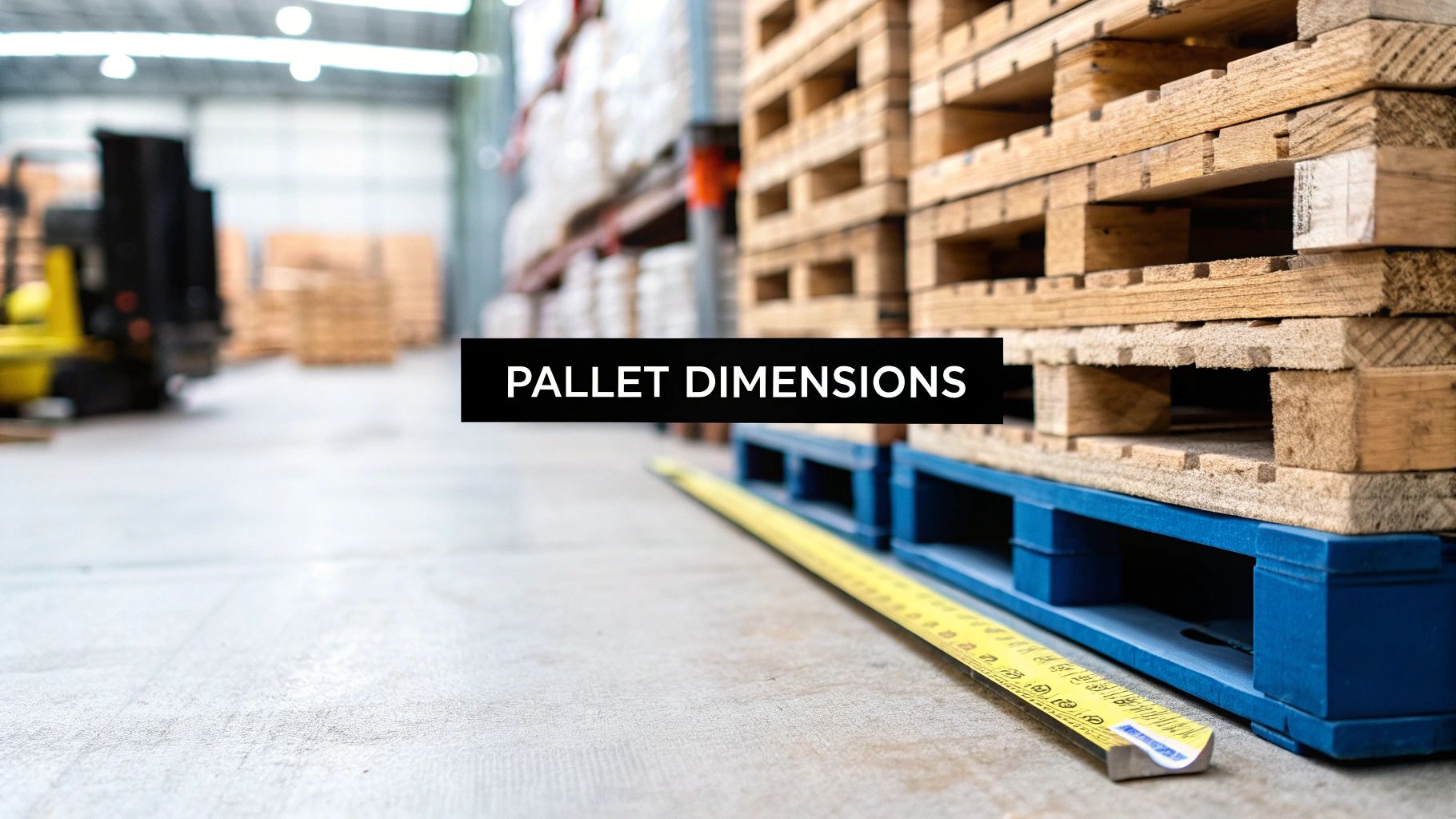
You’ve probably seen them a million times, stacked in warehouses or being loaded onto trucks. While a standard shipping pallet dimension like the 48” x 40” GMA is king in North America, picking the right pallet size is a bigger deal than most people think. It’s a decision that ripples through your entire operation, affecting freight costs, warehouse space, and even how safely your products get where they’re going.
Getting a handle on these simple wooden or plastic platforms is the first real step toward a smarter, more efficient logistics strategy.
Think of pallets as the unspoken language of the shipping world. Their standardized sizes are what make today's complex supply chains work, allowing goods to move seamlessly from a manufacturer's floor, onto a truck, and all the way to a retail shelf. Without them, logistics would be pure chaos.
It's a bit like building with LEGO bricks. When all the bricks are a standard size, you can build strong, stable structures that fit together perfectly. That's exactly what standardized pallets do for freight—they create order and efficiency.
When pallets have consistent dimensions, trucks and shipping containers can be packed to the brim, squeezing every last bit of value out of the available space. This is a game-changer for both full truckload (FTL) and less-than-truckload (LTL) shipping, where every square inch has a price tag.
The right pallet doesn't just hold your product; it protects your bottom line. Using standardized dimensions minimizes handling time, reduces the risk of damage, and ultimately lowers your shipping expenses.
This consistency creates a domino effect of efficiency. Warehouse racks are built to fit them, forklifts are designed to lift them, and automated systems can process them without a hiccup. It all adds up to a smooth, predictable flow of goods from point A to point B.
Globally, two main systems set the standard for shipping pallet dimensions, each tailored to its home turf:
Knowing the difference is crucial. Trying to send a GMA pallet to Europe can lead to expensive delays and re-palletizing fees, and using a Euro pallet for a domestic US shipment can cause all sorts of handling headaches. It all starts here, with understanding the basics.
If you've ever shipped anything in North America, you've almost certainly come across the workhorse of the logistics world: the GMA pallet. You can think of it as the default setting for moving goods. Its standard 48" x 40" shipping pallet dimensions make it the most common and easily recognizable pallet in the United States, especially for anyone in the grocery, retail, or consumer goods industries.
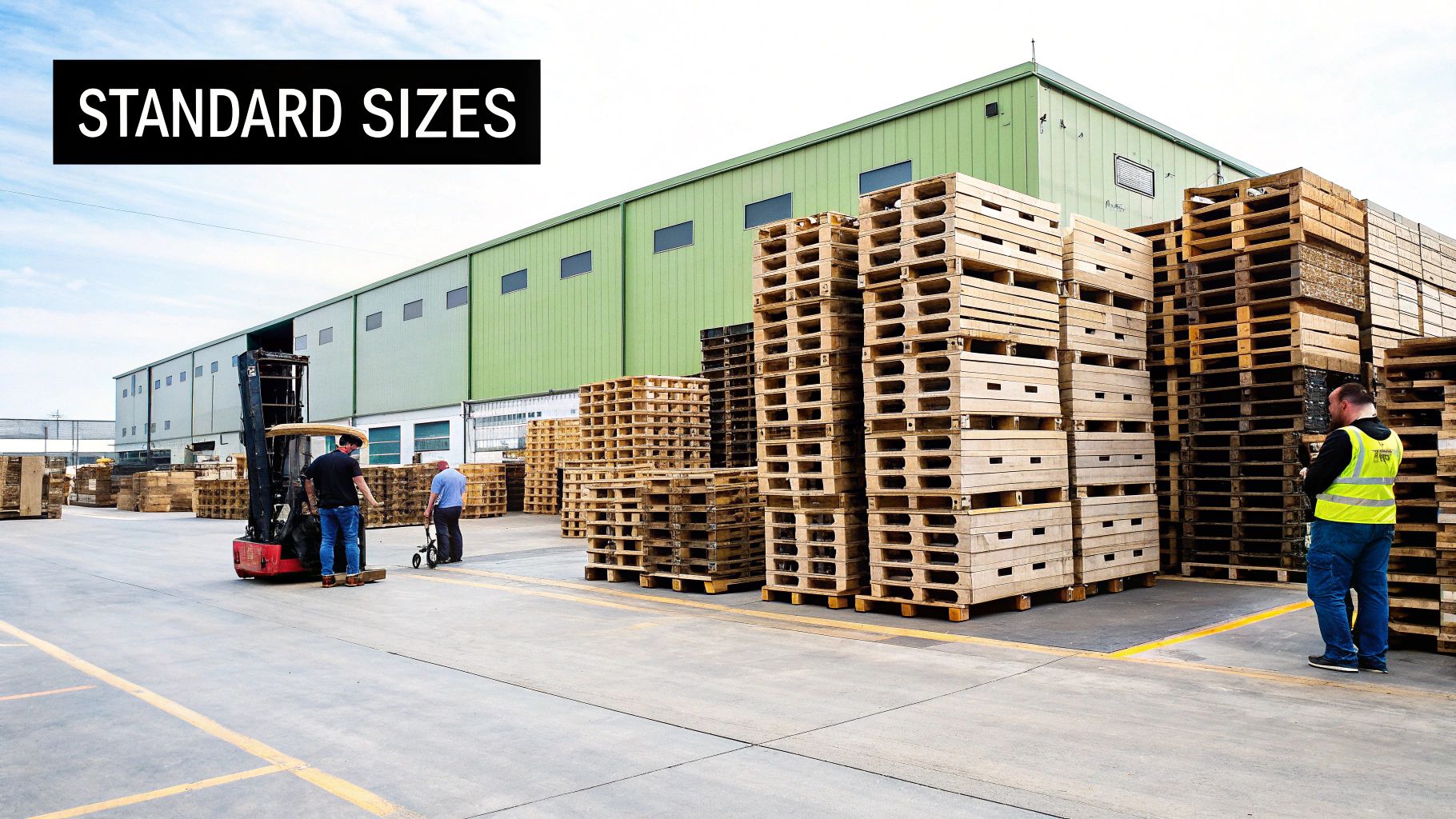
These dimensions weren't just picked out of a hat. They were intentionally designed for maximum efficiency. The Grocery Manufacturers Association (which has since become the Consumer Brands Association) pioneered this design to create a universal standard, making life easier for everyone in the supply chain.
The real brilliance of the GMA pallet lies in how perfectly it slots into the American logistics infrastructure. A standard 53-foot trailer is built to fit two 48" pallets side-by-side or two 40" pallets across its width, which means you can pack a truck tight with minimal wasted space. This thoughtful design extends to just about all material handling equipment, from warehouse forklifts to the pallet jacks on a delivery truck, making loading and unloading a smooth, predictable dance.
This standardization is the secret to its long-standing dominance. The 48 x 40 inch GMA pallet solved a huge logistical headache by creating a common language for freight. It maximizes the usable space in trucks and fits perfectly into standard warehouse racking, which directly translates to lower transportation costs. It’s so efficient, in fact, that it leaves only about 3.7% of floor space unused when loaded into a 40-foot ISO shipping container. You can find more great info on pallet standardization over at Conner Industries.
Because it's so common, the GMA pallet also makes calculating freight density—a critical factor in LTL pricing—much simpler. When you tell a carrier your freight is on a standard GMA pallet, they know exactly what they're working with.
At its core, a GMA pallet is what’s known as a stringer pallet. It's built using three parallel pieces of wood (the stringers) that act as the frame supporting the top deck boards.
A few key features make it so versatile:
Sticking with the GMA standard for your domestic shipments means you're speaking the same language as the entire North American logistics network. It’s a simple choice that helps avoid handling snags, keeps your freight moving, and often leads to better, more predictable shipping rates.
Ultimately, the widespread use of the GMA pallet has created a seamless system. From the automated conveyors in a giant distribution center to a single LTL pickup at a small business, this pallet is simply built to move.
While the GMA pallet is king, it's not the only size you'll see. Different industries have developed their own preferred dimensions to handle specific products. Here’s a quick rundown of some other common sizes you might encounter.
Choosing the right pallet is often the first step in ensuring your freight travels safely and economically. Knowing these common sizes helps you better understand the landscape of North American shipping.
Once your business starts shipping beyond North America, you'll quickly find that the familiar GMA pallet doesn't rule the world. Stepping into international markets means learning a new set of rules, and at the heart of European logistics is the ubiquitous Euro pallet. Think of it as your essential passport for speaking the global language of shipping.
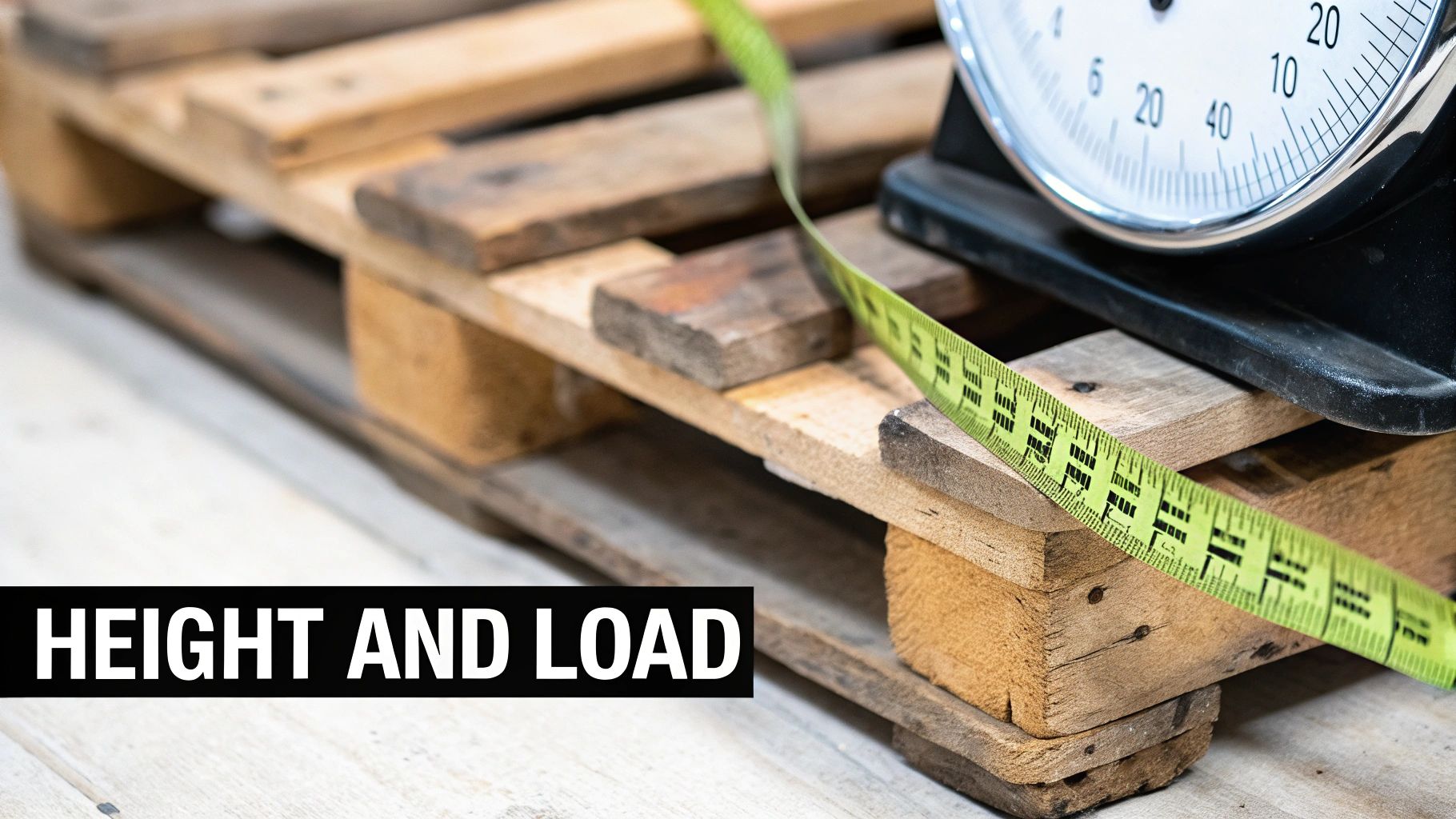
The moment your freight leaves the continent, the shipping pallet dimensions you rely on will almost certainly change. Getting this wrong can be a painful lesson, leading to expensive delays, customs headaches, and frustrating re-palletizing fees at overseas warehouses. A little prep work here will save you a world of trouble.
The most common international pallet you’ll run into is the EUR 1, which measures 800mm x 1200mm (that's about 31.5 inches by 47.2 inches). Its design isn't random; it has deep roots in the history of the continent's transportation networks.
European railway companies originally developed this size to standardize how freight was handled across their vast rail systems. It was a game-changer, dramatically speeding up loading and unloading across borders. This history explains why the Euro pallet is still the top dog in Europe—its dimensions are perfectly optimized for the region’s trucks, warehouse racks, and even standard doorways.
Using the correct regional pallet isn't just a friendly suggestion; it's a critical requirement for smooth international trade. It’s what keeps your products moving through foreign supply chains without hitting costly roadblocks.
Trying to ship to Europe without using the Euro pallet standard is just asking for trouble. Your shipment could be flat-out rejected by a distribution center or forced to undergo manual restacking, piling on both time and expense. This is especially true for LTL freight, where every bit of efficiency counts.
While the Euro pallet is king in Europe, other parts of the world have their own standards, many of which are recognized by the International Organization for Standardization (ISO). These pallets are all about optimizing trade within specific economic zones.
Asia: In many Asian countries, you'll frequently see the 1100mm x 1100mm (roughly 43.3" x 43.3") pallet. This square footprint is incredibly popular because of how efficiently it packs into standard sea containers.
Australia: Down under, the dominant pallet is 1165mm x 1165mm (about 45.9" x 45.9"). It was specifically designed to fit perfectly inside the RACE railway containers used across the country.
Getting a handle on these regional differences is absolutely essential for any business operating on a global scale. Choosing the right pallet from the get-go ensures your goods are handled smoothly, whether they’re landing in Hamburg, Shanghai, or Sydney.
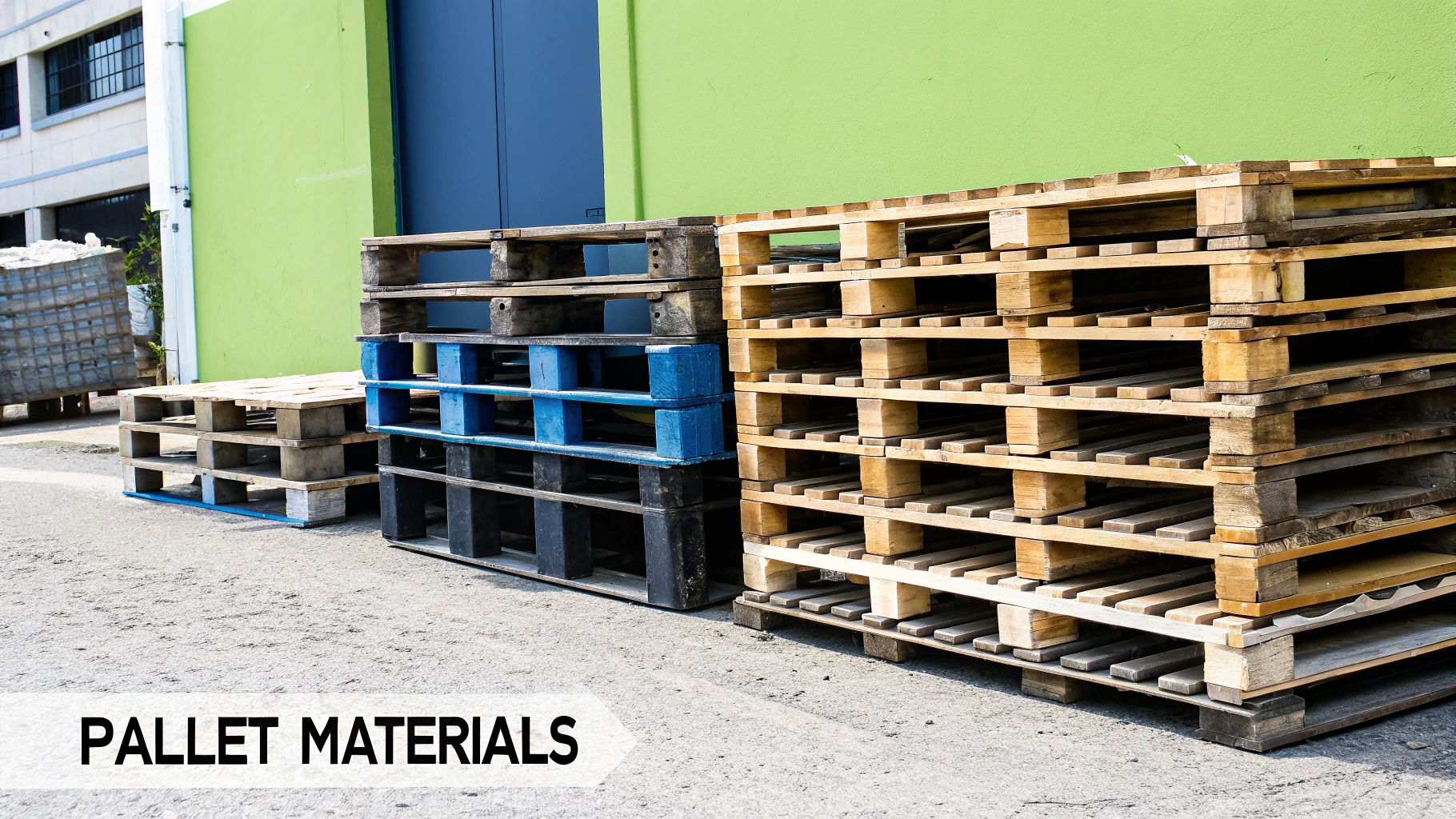
Getting a freight quote that sticks comes down to one thing: providing accurate information. Think of it like getting a custom suit made—if your measurements are even a little off, the final product won't fit right. The same goes for freight. Giving a carrier the wrong shipping pallet dimensions is a fast track to surprise fees and frustrating billing adjustments.
To sidestep those headaches, you need to measure your loaded pallet exactly how a carrier will. This means capturing its absolute maximum footprint, including any part of your product that hangs over the edge. Let’s walk through the simple steps to get it right every single time.
Before you can request a quote, you’ll need to grab a tape measure and find three key numbers: length, width, and height. Always measure and record your findings in inches.
The most common mistake we see is shippers forgetting to account for product overhang. If your boxes stick out even one inch beyond the pallet’s edge, that extra inch is your new length or width. Always measure the absolute widest and longest points of your cargo, not just the pallet base.
So, why are these numbers so important? Carriers use them to calculate two things that directly drive your LTL shipping costs: cubic volume and freight density.
An accurate height is especially critical for getting the density calculation right. Plus, many LTL carriers have rules about pallet heights and will tack on extra charges for shipments that are too tall to be double-stacked.
Taking a moment to provide exact shipping pallet dimensions ensures your quote is based on reality, not guesswork. It’s a simple step that protects you from unexpected rebills and helps keep your shipping budget right on track.
Ready to see how your dimensions translate into a real-world shipping cost?
Knowing the different pallet sizes is a great start, but picking the right one for your specific shipment? That's where you start to see real savings and efficiency. Choosing a pallet isn't just about whether your boxes fit on it; it's a strategic move that affects your shipping costs, the safety of your cargo, and how quickly it gets to its destination.
This means thinking beyond the pallet itself. You have to consider the size and weight of your products, where in the world they're headed, and even the type of truck or container they'll be traveling in. It’s the difference between just sending something out the door and truly managing your logistics for the best possible result.
Picking a pallet is a lot like choosing the right tool for a job. You wouldn't use a tiny hammer to drive a railroad spike, and you don't need a heavy-duty industrial pallet for a few light boxes. It’s all about matching the tool to the task.
So, where do you start? Ask yourself these three core questions:
This is why just looking at a pallet’s footprint doesn’t tell the whole story. The way it’s built, how you stack your goods on it, and how it fits with other pallets in a truck all work together.
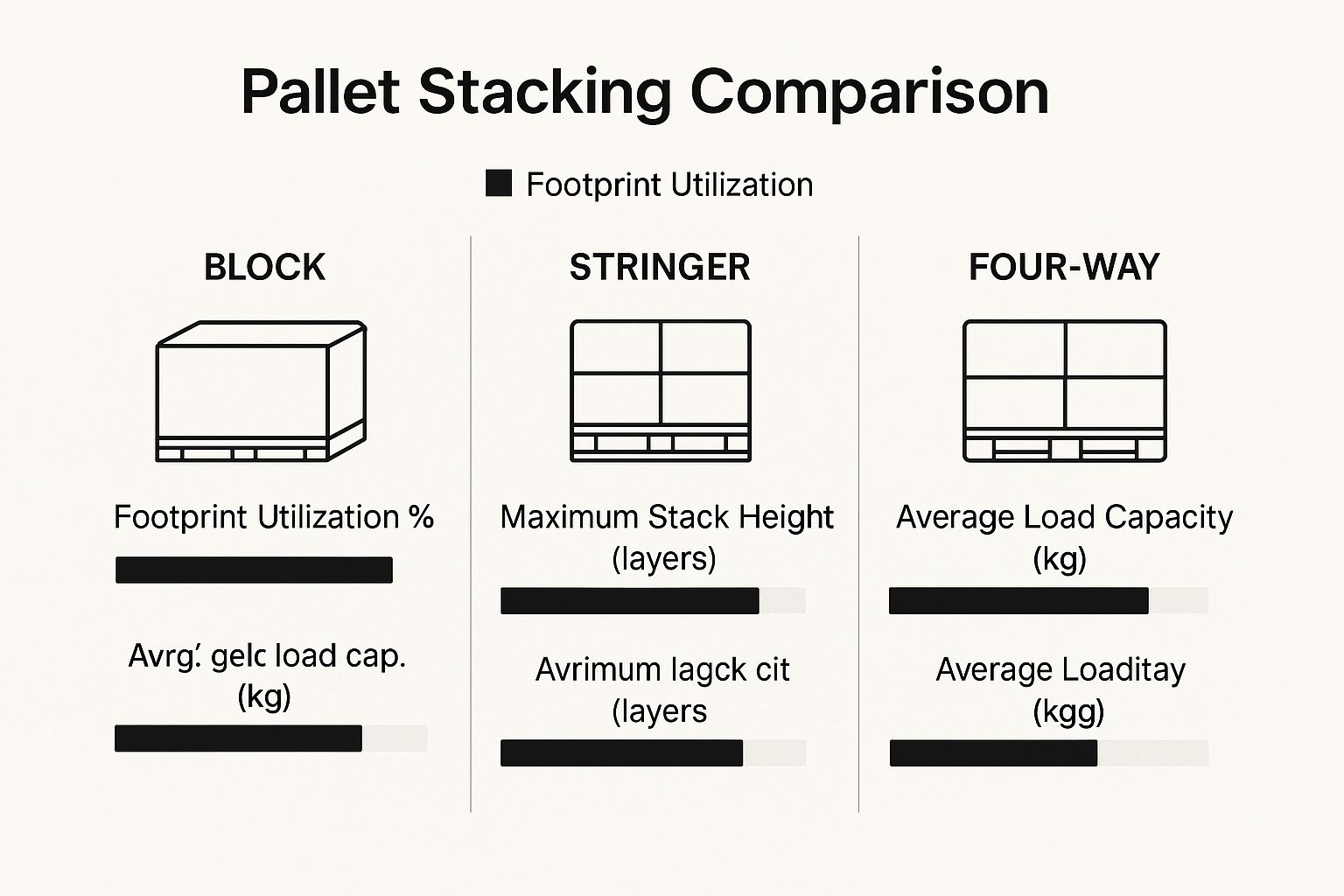
As you can see, small design details like block versus stringer construction can make a big difference in how much product you can safely load and ship.
When you're shipping internationally, following global standards isn't just a good idea—it's essential. The International Organization for Standardization (ISO) stepped in to create a common language for logistics by establishing six universally recognized pallet sizes.
This table breaks down those six ISO-approved pallet dimensions, showing where each one is most commonly used around the globe.
Using the right ISO pallet for your destination country makes everything from unloading to warehousing much smoother, preventing unnecessary headaches and costs in your supply chain.
Finally, don't forget about the material the pallet is made from. Each one has its place.
Wood pallets are the workhorses of the shipping world—they're affordable, reliable, and by far the most common choice for general freight.
But if you're in an industry like food or pharmaceuticals, you'll likely need plastic pallets. They're non-porous and easy to sanitize, making them ideal for sterile environments.
And for those incredibly heavy or valuable industrial goods? Sometimes only a metal pallet will do. They offer unmatched strength and durability when the cargo demands it. The right material ultimately comes down to balancing cost, durability, and the specific needs of your shipment.
Standard pallet sizes are great workhorses, handling the bulk of everyday freight without a problem. But what do you do when your cargo is just... different? Think oversized, awkwardly shaped, or incredibly fragile. That’s when you have to look beyond the standard options and explore the world of custom and specialized pallets.
For anything that won't sit safely on a typical pallet, a custom pallet is your best bet. Trying to ship a massive piece of industrial equipment or a one-of-a-kind sculpture on a standard 48” x 40” base is a recipe for disaster. Custom pallets are built to the exact specifications of your product, creating a perfect-fit foundation that keeps it stable and secure. Yes, they cost more and take longer to get, but that's a small price to pay for protecting high-value items from damage in transit.
It's not always about size and shape. Sometimes, the journey itself dictates the type of pallet you need, especially when your goods are sensitive or crossing international borders. You can't just toss your product on any old wooden pallet and send it overseas.
For any international shipment using wood packaging, the ISPM 15 regulation is non-negotiable. This global standard requires all solid wood pallets to be heat-treated or fumigated to prevent the spread of pests. Compliant pallets get a special stamp, which acts like a passport at customs. Without it, your shipment can be held, rejected, or even destroyed.
Getting the pallet material and treatment right isn't just a suggestion—it's often a legal requirement. A non-compliant pallet can lead to seized cargo, steep fines, and massive delays that ripple through your entire supply chain.
The material of the pallet is also a critical decision, especially in industries with strict hygiene or weight demands.
Plastic Pallets: Think food processing or pharmaceuticals. In these fields, sanitation is everything. Plastic pallets are the go-to choice because they're non-porous, easy to clean and sanitize, and resistant to moisture and chemicals.
Metal Pallets: When you're moving seriously heavy loads—like automotive engines or raw steel—wood and plastic just won't cut it. Steel or aluminum pallets provide incredible strength and durability, handling extreme weights with ease.
Whether you need a custom-built base for an odd-shaped item, heat-treated wood for an international trip, or a sterile plastic platform, knowing about these specialized options will prepare you for any shipping challenge that comes your way.
Even with the basics down, it's totally normal to have a few lingering questions about pallet dimensions. After all, getting these final details right is what separates a smooth, affordable shipment from a frustrating one. Let's tackle some of the most common questions we hear from shippers every day.
The undisputed king of pallets in the United States is the 48-inch by 40-inch model. You'll hear this one called the GMA pallet, short for the Grocery Manufacturers Association standard.
It became the go-to for a simple reason: it’s incredibly efficient. This size fits perfectly into standard 53-foot truck trailers, minimizing wasted space, and it's compatible with just about any forklift or pallet jack you'll find in a North American warehouse.
You don't have to, but you'll almost always want to. Sticking with a standard size, especially the 48"x40" GMA pallet, makes your life and your carrier's life much easier for LTL (Less Than Truckload) shipments.
When carriers can easily group your standard-sized pallet with others, the whole system runs more efficiently, and those savings often get passed on to you. If you ship on a non-standard or oversized pallet, you're likely to get hit with an "oversize fee" because it disrupts the carrier's ability to neatly pack the trailer. It can be a real budget-buster.
For a deeper dive into controlling your shipping expenses, check out our guide on how to reduce freight costs.
This is a critical step, so pay close attention! You need to provide the total dimensions of the fully loaded pallet. This isn't just the size of your product; it's the entire footprint of your shipment from edge to edge and floor to top.
Measure the longest, widest, and tallest points of the entire shipment, including the pallet itself and any product that might be hanging over the edges.
Let's walk through an example. Say your product is 40"L x 40"W x 50"H, and you place it on a standard 48"L x 40"W x 5"H pallet. Your final shipping dimensions are 48"L x 40"W x 55"H. You must add the pallet's height to your product's height. Getting this right from the start is the best way to get an accurate quote and avoid surprise rebilling charges later.
Have your final dimensions ready? Let’s get you a quote that matches what you're actually shipping, with no hidden surprises.